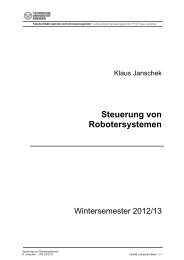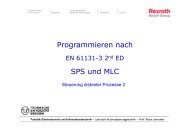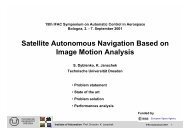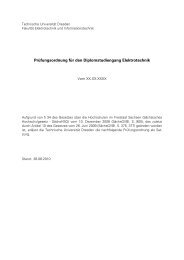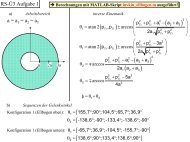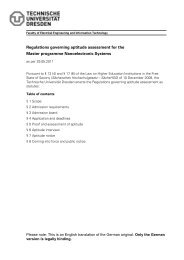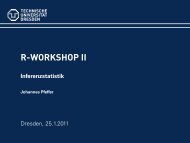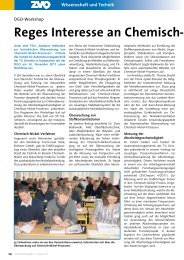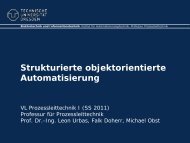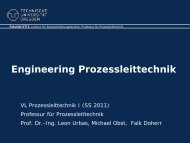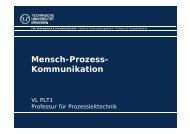the advanced concept of small satellite integrated navigation system ...
the advanced concept of small satellite integrated navigation system ...
the advanced concept of small satellite integrated navigation system ...
You also want an ePaper? Increase the reach of your titles
YUMPU automatically turns print PDFs into web optimized ePapers that Google loves.
on-ground complex; pseudorange and pseudorange rate<br />
<strong>system</strong>atic and random measurement errors caused by<br />
ionosphere delay, receiver clock drift and internal<br />
receiver noise; carrier phase difference measurement<br />
<strong>system</strong>atic and random errors caused by multi-path<br />
phenomenon, receiver clock drift, internal receiver<br />
noise; <strong>system</strong>atic and random errors <strong>of</strong> <strong>system</strong><br />
initialization caused by <strong>the</strong> errors <strong>of</strong> auxiliary sensors<br />
data.<br />
A recursive Bayes algorithm (a modification <strong>of</strong><br />
Kalman filtering) or <strong>the</strong> Least Mean Square algorithm<br />
has been used for user position and velocity<br />
determination. The latter has been used also for <strong>the</strong> user<br />
attitude determination.<br />
As it was said above, two levels <strong>of</strong> <strong>the</strong> used models<br />
have been developed for simulation: <strong>the</strong> more accurate<br />
model and integration method for «true» ephemerides<br />
generation and simplified model and integration<br />
algorithm for simulation <strong>of</strong> both <strong>navigation</strong> messages<br />
and «onboard» short-term ephemerides generation.<br />
Ma<strong>the</strong>matical model <strong>of</strong> <strong>the</strong> <strong>navigation</strong>al <strong>satellite</strong>s<br />
motion<br />
Firstly, let us pay attention to <strong>the</strong> «true» ephemerides<br />
generation technique. Below we turn our attention only<br />
to its main specific features.<br />
The ma<strong>the</strong>matical model <strong>of</strong> «true» ephemerides<br />
generation considers influence <strong>of</strong> <strong>the</strong> following<br />
uncontrollable factors (disturbances): force resulting<br />
from <strong>the</strong> Earth oblateness according to Cunningham<br />
expansion 3 till <strong>the</strong> 8th order, force resulting from Sun<br />
and Moon gravitational influence, aerodynamic drag<br />
force, force resulting form <strong>the</strong> solar pressure.<br />
The highly accurate Dormand-Prince integration<br />
method 3 <strong>of</strong> <strong>the</strong> 5(4) order with automatically adjustable<br />
step has been used for computation GPS and<br />
GLONASS <strong>satellite</strong>s «true» position and velocity,<br />
considering <strong>the</strong> above mentioned disturbances. To<br />
provide efficiency <strong>of</strong> obtained integration results<br />
utilization, one uses Chebyshev’s polynomial<br />
approximation technique 3 . The order <strong>of</strong> polynomial was<br />
accepted equal to 16 and approximation interval has<br />
been accepted equal to 1000 sec.<br />
The simplified model for simulation <strong>of</strong> both<br />
<strong>navigation</strong> messages and «onboard» short-term<br />
ephemerides generation (so called «reference» data)<br />
considers <strong>the</strong> force resulting from <strong>the</strong> Earth oblateness<br />
according to Cunningham expansion till <strong>the</strong> 2nd order<br />
and force resulting from Sun and Moon gravitational<br />
influence.<br />
The standard Runge-Kutta integration method <strong>of</strong> <strong>the</strong><br />
2/6 rule with fixed step was used for computation <strong>of</strong><br />
GPS and GLONASS <strong>satellite</strong>s «reference» position and<br />
velocity, considering <strong>the</strong> above mentioned disturbances.<br />
To utilize <strong>the</strong> obtained integration results for<br />
«reference» ephemerides generation Chebyshev’s<br />
polynomial approximation technique has been used as<br />
well.<br />
To simulate <strong>the</strong> error <strong>of</strong> ephemerides maintenance<br />
one uses «true» ephemerides, corresponding to <strong>the</strong><br />
closest half an hour, «distorted» by <strong>the</strong> additive random<br />
vector with zero ma<strong>the</strong>matical expectation and diagonal<br />
covariance matrix with <strong>the</strong> following r.m.s. values:<br />
σ r = σl<br />
= σn<br />
= 10m.<br />
; σ 0 05m<br />
s,<br />
r � = σ�<br />
= σ l n�<br />
= . /<br />
where <strong>the</strong> r, l, n subscripts denote radial, tangential and<br />
normal directions correspondingly.<br />
Ma<strong>the</strong>matical model <strong>of</strong> <strong>the</strong> user <strong>satellite</strong> motion<br />
Two levels <strong>of</strong> <strong>the</strong> models complexity have been used<br />
for simulation <strong>of</strong> <strong>the</strong> user motion: <strong>the</strong> more accurate<br />
models and integration method for «true» <strong>satellite</strong><br />
position and velocity computation and simplified model<br />
and integration algorithm for <strong>the</strong> «reference» data<br />
generation by <strong>the</strong> «onboard» s<strong>of</strong>tware. The highly<br />
accurate technique for <strong>the</strong> user position and velocity<br />
computation is <strong>the</strong> same as for <strong>the</strong> «true » GPS and<br />
GLONASS <strong>satellite</strong>s ephemerides generation.<br />
To use <strong>the</strong> obtained integration results for <strong>the</strong> user<br />
«true» ephemerides generation one uses Chebyshev’s<br />
polynomial approximation technique. The order <strong>of</strong><br />
polynomial is equal to 16 and approximation interval is<br />
equal to 500 sec.<br />
The simplified «onboard» user motion model for <strong>the</strong><br />
«reference» data performing considers <strong>the</strong> force<br />
resulting from <strong>the</strong> Earth oblateness according to<br />
Cunningham expansion till <strong>the</strong> 2nd order and <strong>the</strong><br />
aerodynamic drag force.<br />
The standard Runge-Kutta integration method <strong>of</strong> <strong>the</strong><br />
2/6 rule with fixed step is used for computation <strong>of</strong> <strong>the</strong><br />
user «reference» position and velocity, considering <strong>the</strong><br />
above mentioned disturbances. A priori data are used as<br />
initial conditions for <strong>the</strong> «onboard» equations <strong>of</strong> <strong>the</strong><br />
user motion. Later <strong>the</strong> current estimations <strong>of</strong> position<br />
and velocity are used, when «User position and<br />
velocity data processing algorithm» unit is initialized.<br />
The simplest model <strong>of</strong> <strong>the</strong> user angular motion was<br />
accepted as <strong>the</strong> «onboard» one due to LMS algorithm<br />
utilization in <strong>the</strong> «User attitude data processing<br />
algorithm» unit, namely:<br />
ref<br />
ref<br />
Es = 0,<br />
Es<br />
= ( ϑ ψ γ)<br />
� ,<br />
where υ, ψ, γ are pitch, yaw and roll correspondingly.



